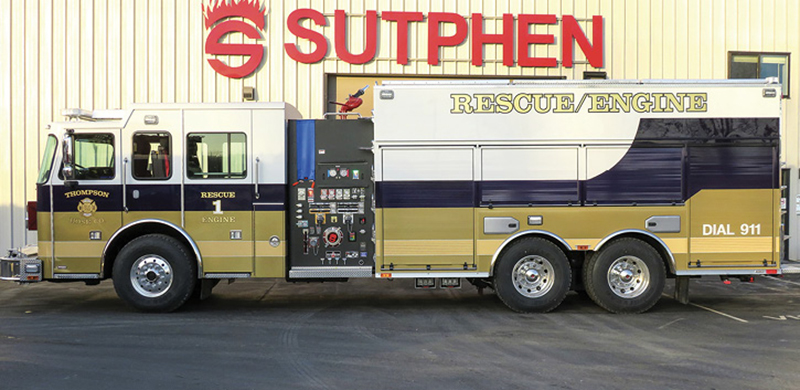The Thompson Hose Company is an all-volunteer fire company serving the residents of three boroughs and three townships in Susquehanna and Wayne counties in Pennsylvania. The company covers more than 110 square miles and has a population of 2,206 residents spread out throughout the mostly rural, farmland areas.

According to Chief Chad Wallace, “Our neighboring mutual-aid response district has most of the commercial areas that we would respond to. Our truck committee, which is comprised of our chief and line officers, met over two years ago to decide what our present and future need would be and what type of vehicle we needed to spec out. We tried to give everyone on the committee an equal say in the building of the new vehicle.”
The fire company had planned to sell a 2007 Spartan Crimson 4×4 rescue-pumper. According to Wallace, it lacked adequate compartment space, and the fire company wanted to hold more water to respond to its rural areas as well as be able to carry extrication tools and the normal forcible entry and hand tools. The committee decided on a 2,000-gallon-per-minute (gpm) single-stage pump as well as an 1,800-gallon water tank. “Having increased compartment space was paramount to us,” says Wallace, “since we wanted additional space to carry any new equipment we may purchase in the future.”

1 The pumper-tanker built on a Sutphen Monarch cab and chassis for the Thompson Hose Company. (Photo 1 courtesy of Sutphen Corporation.)
Thompson Hose Specs
|

2 The pumper-tanker’s officer’s side showing portable fans, generator, forcible entry tools, saws, tarps, and miscellaneous hand tools. (Photos 2 and 3 courtesy of the Thompson Hose Company.)

3 The pumper-tanker’s driver’s side showing extinguishers, extrication tools, portable hand lamps, and a Little Giant™ ladder.
The committee invited several fire apparatus manufacturers during the bidding process to introduce its specs. The committee eventually chose Sutphen.“ We went with Sutphen because they met all of our specs and because they would be building the vehicle at Sutphen East, which is 55 miles from our area,” says Wallace. “This made it a lot easier for us to visit the factory during the build process. As it was, we made two factory visits to the Sutphen East factory with virtually no changes made during these visits.” The cab was built at Sutphen’s Ohio facility and body constructed at Sutphen East. The committee decided to spec a 3⁄16-inch extruded aluminum body to withstand the harsh winters of its region.
Wallace says, “For the build, we went with a 2,000-gpm single-stage pump, an 1,800-gallon polypropylene tank, and a 20-gallon Class A Foam tank. Tool-wise we are able to carry two hydraulic rams, two cutters, different size air bags, portable fans, handlamps, a portable 9,000-watt generator, and electric hand tools.”
The unit carries 1,500 feet of 5-inch large-diamater hose (LDH), two 1¾-inch preconnected handlines (300 feet each), 200 feet of 2½-inch line, and 200 feet of 1-inch booster line.
“The added coffin compartments we had Sutphen design for the top of the body gave us additional compartment space that we didn’t have before,” adds Wallace. “The coffin compartments enable us to carry additional self-contained breathing apparatus and chimney fire extinguishment equipment as well.”
Wallace says, “We were really happy with Sutphen and its local dealer Signal 1 Fire Equipment. They really took care of all of our needs during the build and service after the build process. The build process took approximately one year, eight months, which in the present fire apparatus building climate was really good our committee members thought.”
The Thompson Hose Company started the planning process a few years ago to build this new apparatus. It wanted the vehicle to handle structure fires, extrication at auto accidents, and water supply in the mostly rural area of its response district. It would also be able to operate in its mutual-aid response district as well, which consists of most of the commercial occupancies in its response area. The truck committee took into account the amount of hose carried as well as tools, saws, generators, fans, and extrication equipment. The truck committee also ensured that the apparatus would have added compartment space for future use should the fire company purchase additional equipment in the future.
As I always mention in my columns, think proactively for what the future may bring. New technology with battery-powered tools, fans, and saws is an ongoing process. The added compartment space will never go to waste. The Thompson Hose Company felt the vehicle was well thought out and planned out. With the additional help it received from Sutphen and Signal 1 during the spec-writing phase, the fire company received a vehicle it will be able to use well into the future.
BOB VACCARO has more than 40 years of fire service experience. He is a former chief of the Deer Park (NY) Fire Department. Vaccaro has also worked for the Insurance Services Office, the New York Fire Patrol, and several major commercial insurance companies as a senior loss-control consultant. He is a life member of the IAFC.

